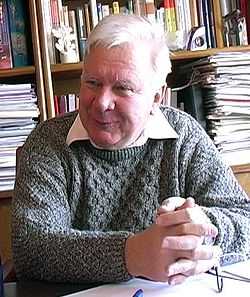Vladimir E. Zakharov
| Vladimir Zakharov | |
|---|---|
|
In his office, 2003 | |
| Born |
August 1, 1939 Kazan, USSR |
| Residence | United States |
| Nationality | Russian |
| Fields | Physics |
| Institutions |
Landau Institute for Theoretical Physics University of Arizona Lebedev Physical Institute |
| Alma mater | Novosibirsk State University |
| Doctoral advisor | Roald Sagdeev |
| Doctoral students | Sergei Manakov |
| Known for | Theoretical physics |
| Notable awards | Dirac Prize (2003) |
Vladimir Evgen'evich Zakharov (Russian: Влади́мир Евге́ньевич Заха́ров) (born August 1, 1939) is a Soviet and Russian mathematician and physicist. He is currently Regents' Professor of mathematics at The University of Arizona[1] and director of the Mathematical Physics Sector at the Lebedev Physical Institute. Zakharov's research interests cover physical aspects of nonlinear wave theory in plasmas, hydrodynamics, oceanology, geophysics, solid state physics, optics, and general relativity.[2]
Zakharov was awarded the Dirac Medal in 2003 for his contributions to the theory of turbulence, with regard to the exact results and the prediction of inverse cascades, and for "putting the theory of wave turbulence on a firm mathematical ground by finding turbulence spectra as exact solutions and solving the stability problem, and in introducing the notion of inverse and dual cascades in wave turbulence."[3]
Vladimir Zakharov is also a poet. He has published several books of poetry in Russia and his works regularly appear in periodicals. A collection of his poetry in an English translation The Paradise for Clouds was published in the UK in 2009.[4]
Biography
Vladimir Zakharov was born in Kazan, Russian SFSR in 1939, to Evgeniy and Elena Zakharov, an engineer and a schoolteacher. He studied at the Moscow Power Engineering Institute and at the Novosibirsk State University,[5] where he received his specialist degree in physics in 1963 and his Candidate of Sciences degree in 1966, studying under Roald Sagdeev. Vladimir Zakharov is married, he has 3 sons. Also, he writes poems and his works were published in Novy Mir in 1990-s and 2000-s.
Academic career
After completing his Candidate of Science degree, Zakharov worked as a researcher at the Budker Institute of Nuclear Physics in Novosibirsk, where in 1971 he completed his Doctor of Sciences degree. In 1974, Zakharov moved to the Landau Institute for Theoretical Physics in Chernogolovka, where he eventually became director. He was elected as a corresponding member of the Academy of Sciences of the Soviet Union in 1984 and as a full member in 1991. In 1992, Zakharov became a professor of mathematics at the University of Arizona, and in 2004 he became the director of the Mathematical Physics Sector at the Lebedev Physical Institute.
Awards and honors
- State Prize for research in Plasma Theory, USSR, 1987
- Order of Honors from the State, USSR, 1989
- State Prize of Russian Federation for research in Soliton Theory, Russia, 1993
- Order for the Service to Russian federation, awarded to 60th year anniversary, 1999
- Dirac Medal of the Abdul Sallam International Center for Theoretical Physics, Trieste, Italy, 2003
- Namesake of asteroid 7153 Vladzakharov
- Fellow of the American Mathematical Society, 2012[6]
Selected bibliography
- S. P. Novikov, S. V. Manakov, L. P. Pitaevskii, V. E. Zakharov, Theory of Solitons: The Inverse Scattering Method, Springer-Verlag (1984), ISBN 0-306-10977-8
- V. E. Zakharov, What is Integrability?, Springer-Verlag (1991), ISBN 0-387-51964-5
- V. E. Zakharov, V. S. L'vov, G. Falkovich, Kolmogorov Spectra of Turbulence I: Wave Turbulence, Springer-Verlag (1992), ISBN 0-387-54533-6
- Vladimir Zakharov, The Paradise for Clouds, Ancient Purple Translations (2009), ISBN 0-9563075-0-7
See also
References
- ↑ Home page at the University of Arizona
- ↑ Recent publications
- ↑ Dirac Medal
- ↑ Zakharov, Vladimir (2009). The Paradise for Clouds. Ancient Purple. ISBN 0-9563075-0-7. Retrieved 2009-08-09.
- ↑ Vladimir Zakharov about Russian and American science (in Russian)
- ↑ List of Fellows of the American Mathematical Society, retrieved 2013-09-01.
External links
|
